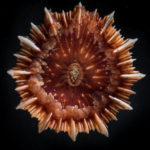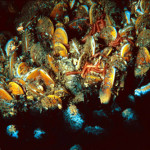
Amidst an odd week of impending deadlines, a national holiday and the celebration that ensues, and record temperatures, I am not ripe for unique contributions to Deep-Sea News right now. Luckily I can rely on the writing of others. So here are some my favorites from the recent.
Ed Yong has my two favorite posts, both with video, this week at his blog.
Cuttlefish woos female and dupes male with split-personality skin
Brown saw a male cuttlefish swimming between a female and a rival male, and displaying different messages to both of them. On his left half, the one the female could see, he flashed zebra-stripe courtship colours to advertise his interest. But on his right half, facing the rival male, he flashed the mottled colours of a female. As far as the competitor was concerned, he was swimming next to two females, oblivious to the act of cross-dressing/seduction going on right next to him. The cheater, meanwhile, prospers.
Bumphead parrotfish use bumpy heads to bump heads
The giant bumphead parrotfish (Bolbometopon muricatum) is the biggest herbivorous fish in coral reefs. It can reach 1.5 metres in length and weigh over 75 kilograms, and it has a distinctively bulbous forehead. Why? There are rumours that it uses its head to ram corals, breaking them up into smaller and easier-to-eat chunks. But Roldan Munoz from the National Oceanic and Atmospheric Administration has discovered one definite use for the bump: headbutting rivals.
Why Sharks Matter discusses at our daughter blog, Southern Fried Science, about a recent genetics that reveals 79 potentially news species of sharks and rays.
A cryptic species is defined as a group that looks almost exactly like another, and may even live in the same region, but is genetically distinct. We’ve known that cryptic species of sharks and rays exist for some time, such as manta rays and scalloped hammerhead sharks, but 79 is a lot; as of the paper’s publication, only 1,221 species of sharks and rays were recognized.
OpenROV is an open source robotic submarine designed to make underwater exploration possible for everyone. It’s also an online community of professional and amateur ROV (remotely operated vehicle) enthusiasts on OpenROV.com.The Goal: to inspire and enable anyone to become a DIY Ocean Explorer. We believe in the power of open source communities to create amazing tools and experiences. This is an invitation to become a co-developer of the OpenROV project.
If you read Deep-Sea News, you know how much we love Osedax bone eating worms. They eat bones and females keep harems of 100’s of males. What is not to love? Recently it was discovered that these worms are even more badass.
Tiny ‘bone-devouring worms’, known to both eat and inhabit dead whale skeletons and other bones on the sea floor, have a unique ability to release bone-melting acid, scientists at Scripps Institution of Oceanography, University of California, San Diego have recently discovered.
That’s right bone-melting acid, which of course makes me think of this.
And I leave you with this







Hey, I appreciate your posting my photo of a mola. I snapped that shot and several others from the deck of the R/V Ron Brown during a cruise to the New England seamounts in 2004.